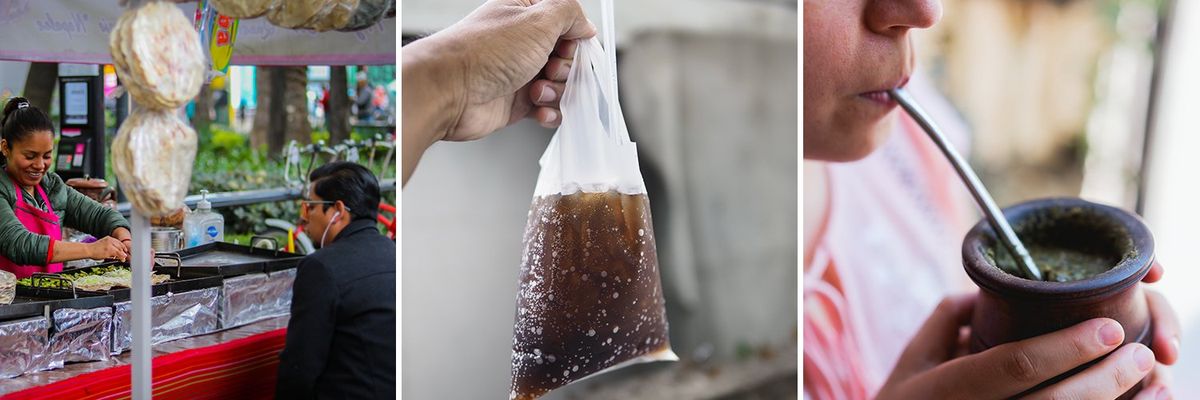
Latin America is a vast region comprising 20 nations and a plethora of cultures, histories, and traditions. As globalization spreads, many age-old quirks and customs are finding their way to the global stage.
For many Latinos, these customs evoke a sense of nostalgia and fondness, while for outsiders, or even younger generations, they may come off as weird or even cringeworthy. The sibling trio Yahritza y Su Esencia recently stirred up controversy when they made what many perceived as negative comments about their recent experience in Mexico City and ultimately apologized after they faced widespread backlash.
But let’s be real - this is nuanced terrain, and not every custom or experience is going to be liked or admired by all so we explore whether these Latin American customs are a beacon of nostalgia or a reason to cringe, or perhaps both.
Drinking Soda from a Bag
In several Latin American countries, especially in street markets, it's not uncommon to be handed your soda in a plastic bag with a straw, rather than in a bottle or can. It's like a DIY drink pouch! They do this so they don't lose out on the bottle, which they often recycle for a return of a small deposit. It also prevents a bunch of empty containers discarded around on the streets.
This tradition brings back memories of hot afternoons and local markets, offering a unique and memorable way to enjoy an ice-cold drink. For many Latinos, it's reminiscent of childhood and simpler times.
But for visitors unaccustomed to the practice, the idea of drinking from a plastic bag may seem wasteful or unsanitary, especially if they lack insight into its original purpose.
The Mate Ritual
Mate is a traditional caffeinated drink consumed mainly in Argentina, Uruguay, Paraguay, and parts of Brazil. The ritual involves drinking from a hollowed gourd with a metal straw and is often a communal activity.
Sharing mate is seen as a symbol of friendship and camaraderie. The act transcends the drink itself and becomes a means of bonding and social connection. Yet, the idea of sharing saliva by passing the gourd and straw can be off-putting to some, especially in a post-pandemic world.
@yerbamatelab I've been drinking yerba mate for 6 years🧉(and not because of Messi) #yerbamate #messi #yerbamatetok #mateuruguayo #yerbacanarias #mateargentino #maté
Being Woken Up By A Loudspeaker In The Morning
Waking up to the sound of a loudspeaker is a quintessential experience for many Latin Americans. Whether it's the all-too-familiar call of "¡Fierro viejo!" for Mexicans, the reminder from the natural gas vendor, or the garbage collection announcement, these loud calls are an integral part of life in many neighborhoods.
For many Latinos, these loudspeaker calls evoke nostalgia, reminding them of the close-knit communities and the rhythm of daily life. Yet, for some, especially those in urbanized zones or the younger generation who value their morning quiet, these calls can understandably be a source of annoyance, and even be viewed as noise pollution.
@raccoonwithpizza credits to irogerp
Eating Street Food While Standing
Street food is the heart and soul of the culinary landscape in many Latin American countries. From savory arepas in Venezuela to sweet churros in Chile, many times, these delights are enjoyed standing up, right on the spot. Holding your plate and drink in one hand while eating with the other is an art form in and of itself.
Eating street food while standing often brings memories of spontaneous moments with family and friends, late-night munchies, or a quick bite during busy days. It's all about the immediacy and intimacy of the moment.
But for those used to dining in seated establishments or valuing a more formal eating environment, this might feel a tad informal or unsanitary, given the bustling street surroundings and potential for food contamination.
@mr.taster World record taco maker in Tijuana, Mexico🇲🇽😍❤️ #taco #tijuana #mrtaster #food #foodlover #foodporn #delicious #restaurant #streetfood
Over-The-Top Telenovela Antics and Low-Quality Cinema
Say what you want to say, but telenovelas are undoubtedly an integral part of Latin American culture, and for many, they’re a daily entertainment staple. From stories of forbidden romances, rags-to-riches tales, and intricate family dramas, these TV series often span hundreds of episodes, keeping viewers hooked for months, even years.
For many Latinos, telenovelas, low-budget shows, and movies are a source of shared experiences. Families gather around the TV in the evenings, eagerly discussing plot twists and character developments. They are an embodiment of passion, drama, and the myriad emotions that define human relationships.
Yet, to the uninitiated, the over-the-top nature of these soap operas can seem excessive. The exaggerated acting, implausible plot turns, and melodramatic confrontations can be a little too much.
@the_mannii Spanish Tv be like: 😂
Latin American customs are like that favorite family album. While some pages make you chuckle or shake your head in disbelief, others bring a teary-eyed smile of nostalgia. But whether it's sipping mate with friends, getting jolted awake by loudspeakers, or being completely engrossed in fictional drama, these customs are the threads that bind the Latin American spirit.
U.S. and Latin American Latinos have to face it - there's a bit of nostalgia and cringe in every culture, and not everything, is for everyone.
- 5 Things Latina Moms Told Us Growing Up ›
- 20 Latino Experiences We All Know Too Well ›
- Top 10 Cringe Life Moments That Are Bound to Happen ›











